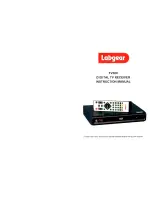
Additional information
12
106
En
i.LINK interface
i.LINK messages
You may see the following messages displayed in the front panel display when using the i.LINK interface.
Symptom
Cause
Remedy
No sound is output.
• An output signal is not produced from the
i.LINK connector on the source player.
• Refer to the manual that came with the source player.
• The selected component is not compatible
with i.LINK audio.
• Refer to the manual that came with the source player.
• The input signal is set to
2
RF
,
DIGITAL
or
ANALOG
.
• Select
i.LINK
or
AUTO
using the
SIGNAL SELECT
button (see
Selecting the input signal type
on page 48).
i.LINK indicator does not light up
even when an i.LINK-equipped
component is selected.
• The
2
RF
,
DIGITAL
or
ANALOG
input
signal is selected.
• Select
i.LINK
or
AUTO
using the
SIGNAL SELECT
button (see
Selecting the input signal type
on page 48).
The program format indicators
don’t disappear when SACD
playback stops.
• The program format indicators remain lit
until another format source is input.
• This is not a malfunction.
You cant get i.LINK to display
when using the
SIGNAL SELECT
button.
• i.LINK-equipped component(s) are not
ready.
• Turn on the component(s).
• i.LINK input setting is incorrect.
• Select the correct i.LINK input setting (see
Assigning
the i.LINK inputs
on page 91).
After upgrading a component, it
is not recognized and cannot be
selected using the i.LINK
connection.
• Depending on the upgrade process, certain
components may cease to be recognized by
the receiver.
• You may need to reset the i.LINK database memory in
the receiver:
With the receiver in standby, press
STANDBY/ON
while holding down
. When you see
DB CLEAR?
appear in the display, press
OPTION–
, then
again to confirm. When you’ve reset the i.LINK database
memory,
DB CLEAR SET
shows in the display.
Message
Explanation
BUS FULL
The i.LINK bus has reached its capacity and cannot transmit any more data.
CANNOT LINK 1
The connection between the receiver and the selected i.LINK-equipped component is unstable. If the
i.LINK cables appear to be connected properly and both the receiver and i.LINK-equipped component are
on, switch both units off, then on again to re-establish the connection between them.
CANNOT LINK 2
The receiver can’t identify the selected i.LINK-equipped component. For example, the receiver may not be
able to identify an i.LINK-equipped personal computer.
LINK CHECK
The receiver is checking the i.LINK network. It does this when components are added to, or removed from
the network. The sound may be interrupted if this happens during playback.
LOOP CONNECT
The i.LINK network cannot function because the connected components form a loop. See
Creating an
i.LINK network
on page 86 for more on this.
NO NAME
When an i.LINK-equipped component has no name, this message is displayed instead of the proper
component name.
NO SIGNAL
A component is outputting an i.LINK signal that the receiver cannot reproduce. This receiver can only
reproduce signals from i.LINK-Audio-equipped components. See
About i.LINK
on page 86 for more on
this.
PQLS OFF
This is displayed when PQLS turns off during playback. The sound may be interrupted momentarily when
this happens.
PQLS ON
This is displayed when PQLS turns on during playback. The sound may be interrupted momentarily when
this happens.
UNKNOWN
When an i.LINK-equipped component name cannot be recognized, this message is displayed instead of
the proper component name.







































